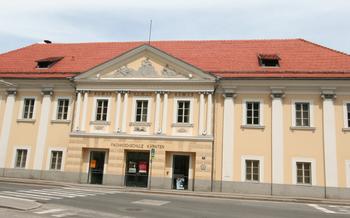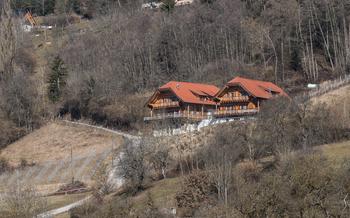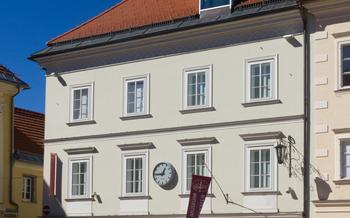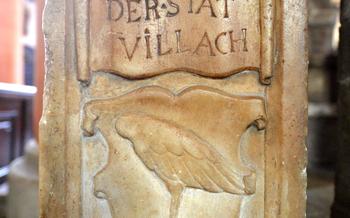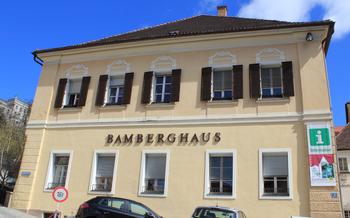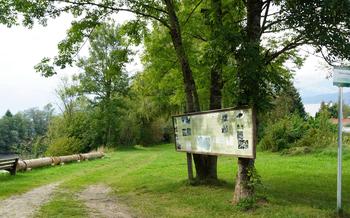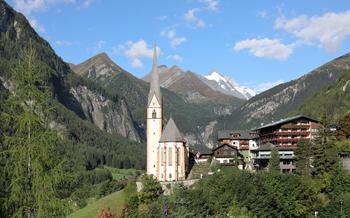
Gurk Cathedral
- Gurk Cathedral: A Stunning Masterpiece
- Marvel at the Romanesque Architecture
- Explore the Gurk Abbey Complex
- Attend a Religious Service or Concert
- Take a Guided Tour for In-Depth Insights
- Admire the Gurk Cross: A Symbol of Faith
- Stroll through the Picturesque Town of Gurk
- Visit the Gurk Castle Ruins for Panoramic Views
- Explore the Gurk Valley for Natural Beauty
- Attend the Gurker Wiesenmarkt: A Traditional Market
- Visit the Nearby Kraigersee Lake for Relaxation
- Learn about the Gurk Diocese and Its History
- Experience the Local Cuisine and Hospitality
- Insider Tip: Discover Hidden Gems Off the Beaten Path
Gurk Cathedral: A Stunning Masterpiece
In the picturesque town of Gurk, nestled amidst the rolling hills of Carinthia, Austria, lies a remarkable architectural gem—the Gurk Cathedral. With its towering spires piercing the sky, this magnificent edifice stands as a testament to the region's rich history, religious devotion, and artistic prowess.
The cathedral's origins date back to the 11th century, when it was founded by Saint Hemma, the Duchess of Carinthia. Over the centuries, it underwent several expansions and renovations, culminating in the awe-inspiring structure we see today. Gurk Cathedral is a stunning example of Romanesque architecture, characterized by its harmonious proportions, sturdy construction, and intricate ornamentation.
Inside, the cathedral boasts a breathtaking array of artistic treasures. The highlight is undoubtedly the Gurk Cross, a magnificent 12th-century crucifix that is widely regarded as one of the finest examples of Romanesque metalwork. The cross is adorned with intricate carvings and precious stones, symbolizing the profound devotion and craftsmanship of the era.
Gurk Cathedral is not only a architectural marvel but also a significant pilgrimage site. For centuries, pilgrims from across Europe have flocked to Gurk to pay homage to the Gurk Cross and seek spiritual enlightenment. The cathedral's sacred atmosphere and rich history make it a place of deep reverence and spiritual connection.
Marvel at the Romanesque Architecture
The Gurk Cathedral represents a prime example of Romanesque architecture, a style that emerged in Europe during the 10th and 11th centuries. Romanesque architecture is characterized by its rounded arches, thick walls, and a focus on solidity and mass. It emerged as a response to the need for larger and more stable structures, following the decline of the Roman Empire.
Gurk Cathedral showcases several notable Romanesque features. Its rounded arches can be seen in the doorways, windows, and the arcades of the nave. The thick walls, constructed from local limestone, provide a sense of strength and stability to the building. The cathedral's interior is characterized by its simplicity and lack of ornamentation, typical of Romanesque architecture.
The cathedral's west facade is a particularly striking example of Romanesque design. It features a series of blind arcades, which are arches that do not open into a space, creating a decorative effect. The facade is also adorned with carved capitals, which depict scenes from the Bible and the lives of saints.
The Gurk Cathedral is a testament to the skill and artistry of the Romanesque builders. Its architectural features reflect the transition from the Late Antique to the Medieval period and stand as a reminder of the enduring legacy of Romanesque architecture in Austria.
Explore the Gurk Abbey Complex
The Gurk Abbey, closely intertwined with the cathedral, holds significant historical and architectural value. Established in the 11th century, the abbey served as the residence of the Gurk bishops and played a pivotal role in the region's religious and cultural development. Its architectural grandeur complements that of the cathedral, showcasing Romanesque and Gothic influences. Visitors can admire the abbey's cloisters, the Chapter Hall with its intricate ceiling frescoes, and the Bishop's Palace, which houses the Gurk Diocesan Museum.
Highlights of the Abbey Buildings:
-
The cloisters, featuring serene arcaded walkways and a peaceful ambiance, offer a tranquil retreat for contemplation.
-
The Chapter Hall, a masterpiece of Gothic architecture, boasts an awe-inspiring vaulted ceiling adorned with 14th-century frescoes depicting scenes from the life of Christ.
-
The Bishop's Palace, a testament to the opulence of the Gurk bishops, showcases a blend of Romanesque and Gothic elements, including a grand staircase and ornate reception halls.
Role of the Abbey in the Region's Heritage:
-
The Gurk Abbey served as the administrative and spiritual center of the Gurk diocese for centuries, influencing the religious and cultural landscape of the region.
-
The abbey's scriptorium was renowned for its production of illuminated manuscripts, contributing to the spread of knowledge and culture throughout the diocese.
-
The abbey's extensive landholdings and economic activities played a vital role in the development of the surrounding area, fostering agriculture, trade, and community growth.
Attend a Religious Service or Concert
The Gurk Cathedral not only serves as a historical and architectural marvel but also as a living place of worship. Attending a religious service or concert within the cathedral's hallowed halls offers a unique and deeply moving experience.
Religious Services:
Regular religious services, including masses, prayers, and special ceremonies, are held throughout the week. Visitors are welcome to join the local congregation and immerse themselves in the spiritual atmosphere of the cathedral. The services are conducted in German, but visitors can still appreciate the beauty of the rituals and the devotion of the worshippers.
Concerts and Musical Performances:
The Gurk Cathedral is renowned for its exceptional acoustics, making it a popular venue for concerts and musical performances. Throughout the year, the cathedral hosts a variety of concerts, ranging from classical music recitals to traditional Carinthian folk music. Attending a concert in this sacred space is a truly unforgettable experience, allowing visitors to appreciate the cathedral's beauty while enjoying the uplifting power of music.
Dress Code and Etiquette:
When attending religious services or concerts at the Gurk Cathedral, visitors are expected to dress respectfully. Modest attire is recommended, and visitors should avoid wearing shorts, tank tops, or revealing clothing. During services, it is customary to stand when the congregation stands, sit when they sit, and kneel when they kneel. Visitors are also expected to maintain a respectful silence and refrain from talking or using their mobile phones during the service.
Spiritual Reflection and Cultural Appreciation:
Attending a religious service or concert at the Gurk Cathedral provides an opportunity for both spiritual reflection and cultural appreciation. Visitors can immerse themselves in the sacred atmosphere of the cathedral, contemplate the significance of the rituals, and appreciate the beauty of the music. It is a chance to connect with the local community, gain a deeper understanding of Austrian culture, and create lasting memories of their visit to Gurk.
Take a Guided Tour for In-Depth Insights
To gain a deeper understanding of the history, architecture, and significance of Gurk Cathedral and the surrounding abbey complex, consider booking a guided tour. Guided tours are conducted by knowledgeable and experienced guides who can provide in-depth insights into the cathedral's unique features, hidden details, and fascinating stories. They will point out architectural elements, explain the significance of the Gurk Cross, and share anecdotes about the abbey's rich history.
Guided tours are available in different languages, ensuring that international visitors can also benefit from the tour's commentary. By opting for a guided tour, you'll have the opportunity to ask specific questions and receive personalized explanations, enhancing your overall cathedral experience.
To make the most of your visit, booking a guided tour in advance is recommended. This ensures that you can secure a spot on the tour of your preferred language and time. Guided tours typically last for around an hour, allowing you to explore the cathedral's interior, the abbey buildings, and the Diocesan Museum comprehensively.
The cost of guided tours varies depending on the group size and the specific tour package. However, the investment in a guided tour is well worth the additional knowledge and insights you'll gain. It's an excellent way to delve deeper into the history, significance, and beauty of Gurk Cathedral and the surrounding complex.
Admire the Gurk Cross: A Symbol of Faith
The Gurk Cross, also known as the Gurker Kreuz, holds a significant position as a symbol of faith and devotion within the Gurk Cathedral. Created in the 12th century, this exquisite crucifix is crafted from silver and gold and adorned with precious gemstones. According to legend, the cross was discovered by a peasant girl who stumbled upon it while working in the fields. It is believed to possess miraculous powers, attracting pilgrims and visitors from far and wide seeking blessings and spiritual healing. The cross remains a cherished relic, deeply revered by the local community and a captivating sight for all who behold it. Within the cathedral, the Gurk Cross is prominently displayed, inviting visitors to marvel at its intricate artistry and reflect on its profound religious significance.
Stroll through the Picturesque Town of Gurk
Nestled amidst the Gurk Valley's idyllic landscapes, the town of Gurk exudes a charm that belies its small size. As you wander through its cobbled streets, you'll be greeted by an array of historical buildings, each telling a tale of the town's rich past. Admire the intricate facades of the Rathaus (Town Hall) and the Alte Schule (Old School), which date back to the 16th and 17th centuries, respectively. Don't miss the Gurk Heimatmuseum, housed in a former granary, where you can delve into the town's history and traditions.
Pause for a leisurely lunch or coffee at one of the local cafes, savoring the warm hospitality that Gurk is renowned for. Peruse the unique shops, where you can find everything from traditional crafts to local delicacies. As you explore, keep an eye out for the many hidden gems tucked away in the town's nooks and crannies. Whether it's a charming courtyard, a picturesque fountain, or a stunning view of the surrounding mountains, Gurk offers countless opportunities for delightful discoveries.
Take some time to visit the Pfarrkirche St. Stefan, a beautiful 12th-century church that stands as a testament to Gurk's religious heritage. With its Romanesque architecture and intricate frescoes, this church is a sight to behold. As you stroll further, you'll encounter the Gurker Propsteihof, a former provost's residence that now houses the Gurk Diocesan Museum. This museum offers a fascinating glimpse into the history and culture of the Gurk diocese, with exhibits ranging from sacred art to archaeological finds.
Visit the Gurk Castle Ruins for Panoramic Views
Perched atop a hill overlooking the picturesque Gurk Valley, the ruins of Gurk Castle stand as a testament to the region's rich history. Dating back to the 12th century, the castle once served as a strategic stronghold for the Counts of Gurk. Over the centuries, it underwent several expansions and modifications, reflecting the changing needs and tastes of its occupants.
Although the castle fell into disrepair in the 18th century, its ruins still offer a glimpse into its former grandeur. Visitors can explore the remnants of the castle walls, towers, and courtyards, which have been partially restored to provide a safe and accessible environment for exploration.
The highlight of a visit to the Gurk Castle ruins is undoubtedly the breathtaking panoramic views from the top. Visitors can take in stunning vistas of the Gurk Valley, with its patchwork of fields, forests, and villages, as well as the distant peaks of the Carnic Alps. On clear days, it is even possible to see the iconic Pyramidenkogel observation tower, located on the opposite side of the valley.
To reach the castle ruins, visitors can either embark on a scenic hike from the town of Gurk or take a leisurely bike ride along the Gurk Valley Cycle Path. Both options offer a chance to appreciate the natural beauty of the surroundings and soak in the tranquility of the countryside.
Explore the Gurk Valley for Natural Beauty
The picturesque Gurk Valley, nestled amidst the rolling hills and lush forests of Carinthia, offers a haven for nature lovers and outdoor enthusiasts. Whether you seek tranquil walks along scenic trails, exhilarating bike rides through verdant landscapes, or refreshing swims in crystal-clear lakes, the Gurk Valley has something to offer everyone.
Lace up your hiking boots and embark on one of the many well-marked trails that crisscross the valley. Breathe in the invigorating fresh air as you pass through fragrant pine forests, marvel at the breathtaking views from panoramic viewpoints, and encounter charming alpine meadows adorned with wildflowers. For a leisurely experience, rent a bicycle and pedal along the gentle slopes, enjoying the tranquility of the countryside.
After an active day exploring the valley's natural wonders, reward yourself with a refreshing dip in the pristine waters of the Kraigersee lake. Bask in the warm sunshine on the sandy shores, take a rejuvenating swim, or cast your line for a chance to catch some local fish.
Immerse yourself in the local culture by sampling the region's culinary delights. Indulge in hearty Carinthian specialties, such as the iconic Kärntner Kasnudeln (cheese dumplings) or the mouthwatering Reindling (yeast cake with cinnamon and raisins). Quench your thirst with a glass of locally brewed beer or a refreshing glass of wine from the region's vineyards.
As you explore the Gurk Valley, take the opportunity to visit the charming villages and towns that dot the landscape. Discover hidden gems such as the medieval town of Straßburg, with its well-preserved historic center, or the picturesque village of Weitensfeld, known for its traditional Carinthian architecture.
Embrace the warmth and hospitality of the local people, who are proud to share their culture and traditions with visitors. Experience the lively atmosphere of local festivals and events, where you can witness traditional dances, listen to enchanting music, and savor delicious regional specialties.
Whether you seek adventure, relaxation, or cultural immersion, the Gurk Valley promises an unforgettable experience.
Attend the Gurker Wiesenmarkt: A Traditional Market
The Gurker Wiesenmarkt, held annually in Gurk, is a vibrant and colorful traditional market that has been drawing visitors for centuries. Immerse yourself in the lively atmosphere as you browse through a myriad of stalls showcasing unique products, handcrafted goods, and mouthwatering regional delicacies. Experience the warmth of local hospitality and engage with friendly vendors who share their passion for preserving traditional crafts and culinary delights.
The market dates back to the 13th century, when Gurk was granted the right to hold a weekly market. Over time, the market evolved into the renowned Gurker Wiesenmarkt, which takes place every year on the third weekend of September. During these three days, the town transforms into a bustling hub of activity, with locals and tourists alike flocking to enjoy the festivities.
As you stroll through the market, you'll be captivated by the array of goods on display. From traditional clothing and handicrafts to local produce and culinary specialties, there's something for everyone. Sample the region's finest cheeses, savor the sweetness of homemade jams and honey, and indulge in freshly baked pastries that melt in your mouth.
The Gurker Wiesenmarkt is not just a shopping extravaganza; it's also a celebration of local culture and heritage. Throughout the market, you'll find performances by traditional music and dance groups, showcasing the vibrant traditions of the Gurk Valley. Join in the lively atmosphere, dance to the infectious rhythms, and let the spirit of the market sweep you away.
For a truly immersive experience, plan your visit around the traditional opening ceremony, which takes place on Friday evening. Witness the colorful parade of locals in traditional costumes as they make their way through the town, accompanied by music and fanfare. The ceremony culminates in the official opening of the market, after which the festivities kick off in full swing.
Whether you're a seasoned market enthusiast or simply looking for a unique and authentic Austrian experience, the Gurker Wiesenmarkt is a must-visit. Immerse yourself in the vibrant atmosphere, savor the local delicacies, and take home cherished memories of this traditional market that has stood the test of time.
Visit the Nearby Kraigersee Lake for Relaxation
Just a short drive from Gurk, nestled amidst the picturesque landscape of the Gurk Valley, lies the idyllic Kraigersee Lake. This pristine lake, with its crystal-clear waters and serene surroundings, offers a tranquil escape for visitors seeking relaxation and rejuvenation.
The lake's calm surface reflects the lush greenery of the surrounding forests, creating a breathtaking panorama. Visitors can stroll along the lakeshore path, inhaling the fresh air and enjoying the tranquility of nature. For those seeking a more active experience, swimming, sunbathing, and fishing are popular activities at Kraigersee. The lake's crystal-clear waters are perfect for a refreshing dip on a warm summer's day, while the surrounding meadows provide ample space for sunbathing and picnicking. Anglers can also try their luck at catching trout and other fish that inhabit the lake.
Kraigersee is also steeped in local legends and myths, adding to its allure. One legend tells the tale of a beautiful mermaid who is said to inhabit the lake, enchanting visitors with her melodious singing. Another legend speaks of a sunken treasure hidden beneath the lake's surface, waiting to be discovered by a lucky adventurer.
Whether you're seeking relaxation, adventure, or a touch of magic, Kraigersee Lake is a must-visit destination for those exploring the Gurk Valley. Its serene beauty and tranquil atmosphere provide a welcome respite from the hustle and bustle of everyday life, allowing visitors to reconnect with nature and find inner peace.
Learn about the Gurk Diocese and Its History
The Gurk Diocese holds a significant place in the religious and cultural fabric of Austria. Established in 1072, it ranks among the oldest and most influential dioceses in the country. Throughout its history, the diocese has played a pivotal role in shaping the spiritual, intellectual, and artistic landscape of the region.
Over the centuries, the Gurk Diocese has witnessed numerous notable figures and events that have left an indelible mark on its legacy. From its founding bishop, Günther of Krappfeld, to its current bishop, Alois Schwarz, the diocese has been led by a succession of dedicated and influential individuals who have guided its development and growth.
The diocese has also been a patron of the arts, supporting the creation of stunning religious artworks and architecture. The Gurk Cathedral, a masterpiece of Romanesque architecture, stands as a testament to the diocese's commitment to artistic excellence. The cathedral's interior is adorned with exquisite frescoes, sculptures, and stained glass windows, each telling a unique story from the Bible.
Beyond its religious significance, the Gurk Diocese has also played a crucial role in the cultural and educational development of the region. The diocese's schools and institutions have nurtured generations of scholars, artists, and leaders who have contributed to the intellectual and cultural vibrancy of Austria.
Understanding the history and structure of the Gurk Diocese provides a deeper appreciation of its enduring influence on Gurk and the surrounding area. Visitors can delve into the diocese's rich past by exploring its archives, visiting its historical sites, and engaging with its vibrant community of believers.
Experience the Local Cuisine and Hospitality
When visiting Gurk, indulging in the local cuisine is a must. The town offers a range of restaurants and cafes serving traditional Austrian dishes and regional specialties. Sample the hearty and flavorful Kärntner Kasnudln, a type of pasta filled with cheese and herbs. For a taste of local meats, try the Reindling, a sweet bread filled with nuts and spices.
Don't miss the chance to savor the region's wines and beers. Gurk is located in the heart of the Austrian wine country, and you can find a variety of local wines to try. The region is also known for its beer brewing tradition, so be sure to sample some of the local brews.
When dining in Gurk, it's important to respect local customs and etiquette. Austrians generally value punctuality, so arrive on time for your reservation. It's customary to greet the server and other diners with a friendly "Guten Tag" or "Grüß Gott." Tipping is not mandatory but is appreciated, with a customary amount being around 5-10% of the bill.
By embracing the local cuisine and hospitality, you'll gain a deeper appreciation for the culture and traditions of Gurk. So, be sure to indulge in the delicious food, sample the local drinks, and interact with the friendly locals to make your visit a truly memorable one.
Insider Tip: Discover Hidden Gems Off the Beaten Path
Beyond the main attractions, Gurk and its surroundings offer hidden gems waiting to be discovered by curious travelers. For a truly immersive experience, venture off the beaten path and explore lesser-known sights. Visit the idyllic Kraigersee, a crystal-clear lake nestled in the heart of the Gurk Valley, perfect for swimming, sunbathing, and fishing. Discover the enchanting Gurk Castle Ruins, perched atop a hill and offering breathtaking panoramic views. Immerse yourself in the local culture by attending the Gurker Wiesenmarkt, a traditional market showcasing regional crafts and delicacies, accompanied by festive music and performances.
Uncover the secrets of the Gurk Diocese by delving into its rich history and visiting hidden churches and monasteries in the surrounding villages. Seek out local recommendations for insider spots, such as cozy cafes serving traditional Austrian pastries or hidden viewpoints with stunning vistas. Remember to respect local customs and traditions as you explore, embracing the authentic charm of Gurk and its people.
